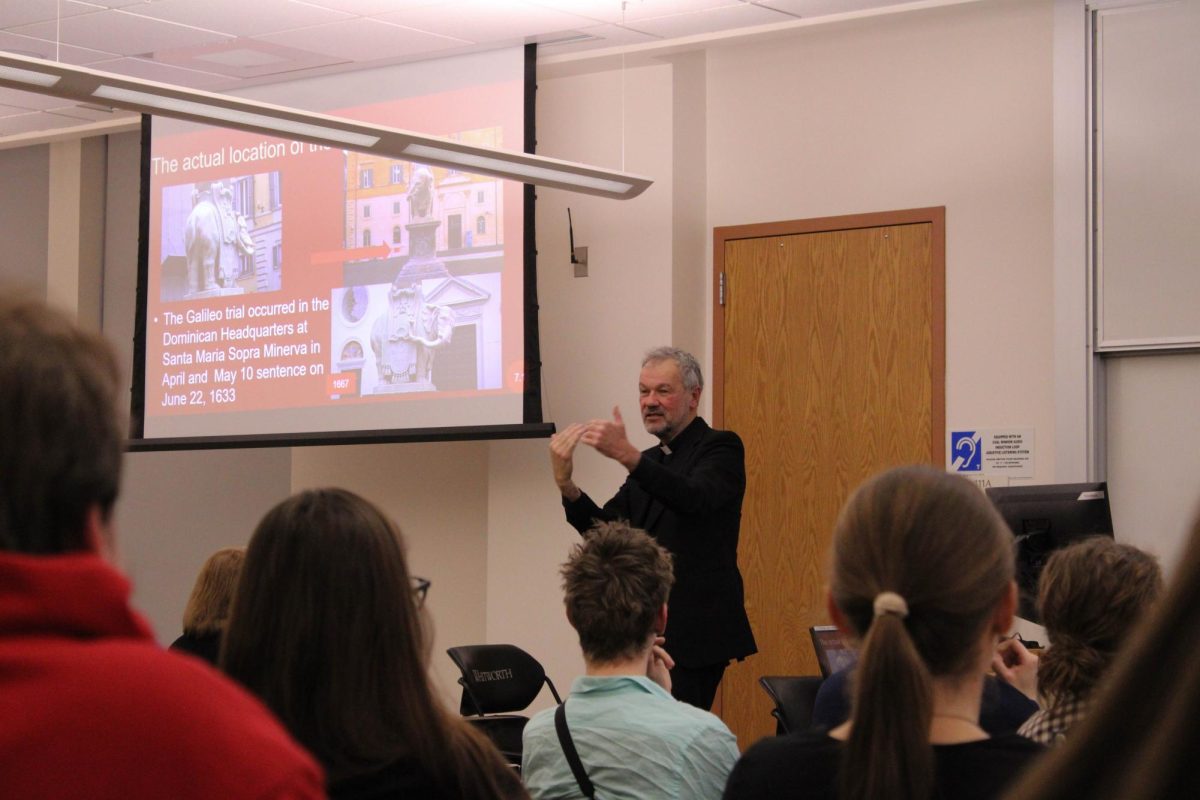by Jonathan Kim
Did you know phrases such as “from time to time” and “the root of the matter” were popularized by the King James Bible? The King James translation introduced 18 classic phrases into the English language and made famous more than 240 of them, according to the December issue of National Geographic.
A crowd gathered in Robinson Teaching Theatre on April 23 for a panel presentation commemorating the 400-year anniversary of the King James Bible. The event was held as a part of the library exhibit “Manifold Greatness: The Creation and Afterlife of the King James Bible,” which opened on April 11.
The panel consisted of English professor Leonard Oakland, assistant art professor Meredith Shimizu and professor of religious studies at Gonzaga University Linda Schearing.
“Manifold Greatness” is a traveling exhibit organized by the American Library Association and the Folger Shakespeare Library in Washington, D.C. It is staying at Whitworth as one of its 40 destinations nationwide. Whitworth and Gonzaga collaborated on the exhibition and panel.
“It’s not the first collaboration done by the two schools,” Schearing said. “It’s great. I hope we have more.”
The panel provided a look at the King James Bible from various angles, examining its history, its past influence, as well as its influence on the present culture.
“It’s a testament to the impact of the Kings James Bible that we’re even having this lecture 400 years later,” freshman theology major Sam Director said.
Oakland discussed the influence of the King James Bible on English literature. He revealed the large extent to which the important text has shaped our language.
Since its first publication in 1611, it had influenced notable figures of English letters, from Mary Wollstonecraft in the 18th century to John Hays Gardiner in the 19th century, Oakland said. It is also alluded to in the works of prominent American authors such as William Faulkner, Ernest Hemingway and Herman Melville. Oakland read passages from John Milton’s “Paradise Lost” and T.S. Eliot’s poems to demonstrate the mark the King James Bible has had on various literary movements.
It has also played a role in preserving particular elements of the English language, including words such as “thee,” “thou” and “unwittingly,” along with phrases still in everyday use such as “labor of love” and “sweat of your brow.”
Shimizu talked about art in the text as well as the presence of the Bible in art. She showed how the style of illustrated images in biblical texts changed over periods of time, notably from decorative ornamentation in early periods such as the late ninth century, to images more representative of the text’s narrative such as those in 16th century publications.
Having been such a significant part of culture in history, it’s no surprise that the Bible found itself as the object of many paintings in the past. Shimizu said it’s no different today, as demonstrated by artistic treatment of the Bible in our present culture. For example, Tauba Auerbach’s “The Alphabetized Bible” (2006) is an unconventional “translation” of the King James Bible, with every letter of the entire text rearranged in alphabetical order (such that the title reads “Bbe ehHi lloTy”). Its purpose is to express how any text, no matter its intellectual weight or sacred value, is merely a collection of letters.
Schearing discussed the Bible in popular culture. She said today, the Bible and its elements find themselves represented in various commercial products and advertising, as they connote meanings and themes that are widely recognized. Those included anything from the TV show “Desperate Housewives” to the marketing strategy of Original Sin Hard Cider.
Schearing said popular culture affects the production of new versions of the Bible. In order to sustain sales, Bible publishers treat it as a commodity that they tailor to particular market niches. We now see the Bible and its messages produced in a wide variety of forms, such as the animated show VeggieTales, teen magazines called “bible-zines” and versions catered to specific interests such as the “Holy Bible: Stock Car Racing Edition.”
Whether those adaptations are justified in their attempts to make the Bible more accessible is a question that may be disagreed upon, and not surprisingly so when there are such versions as “The Brick Testament,” a biblical story book with illustrations of Legos, Schearing said.
“Though the word of God can stand on its own, commercialization can in some ways take away its focus,” Director said. “The inherent problem with these cultural accommodations is that they can de-emphasize the importance of the Bible.”
Whatever the Bible’s role today, it’s no question that its historical significance warrants recognition.
“I think it’s important that we educate ourselves on what has influenced us,” Oakland said. “The King James Bible has had significant influence on us, especially those who have grown up with it.”
The exhibit will remain in the Whitworth library through commencement day on May 13.
Contact Jonathan Kim at jonathankim15@my.whitworth.edu.






